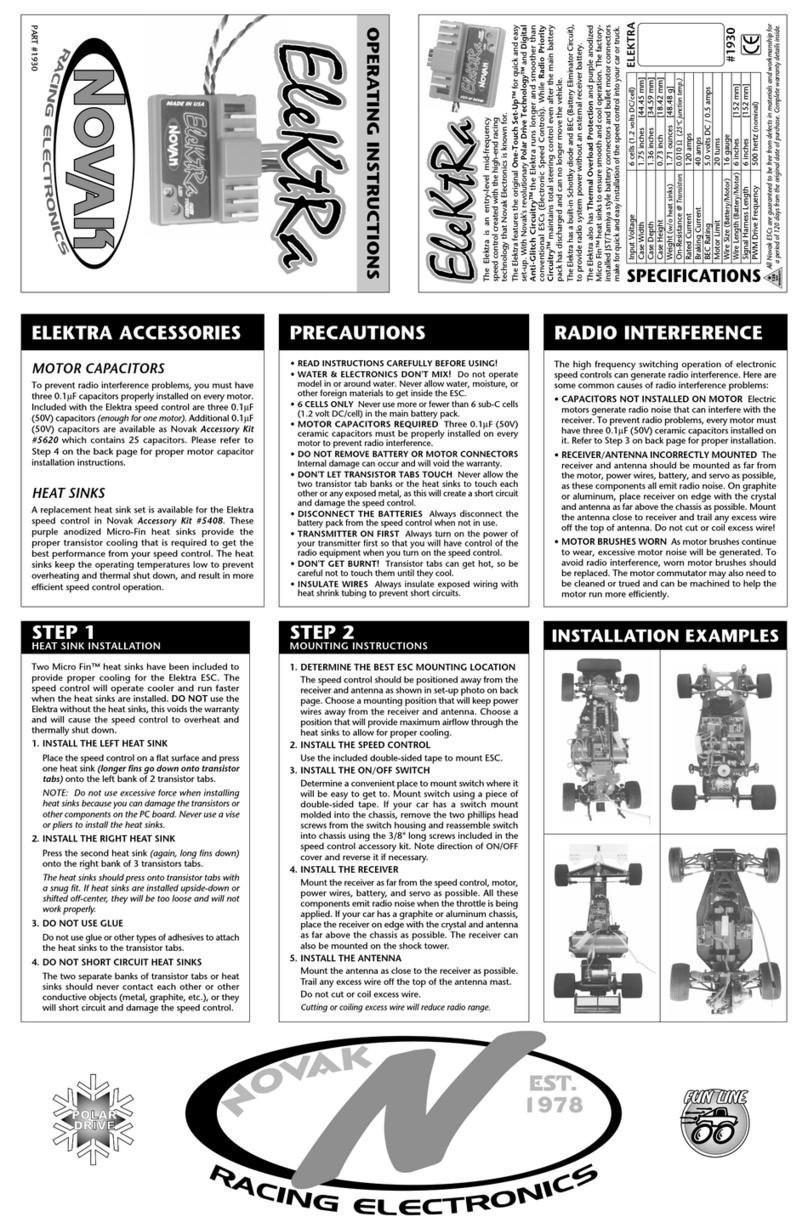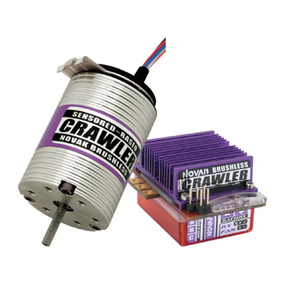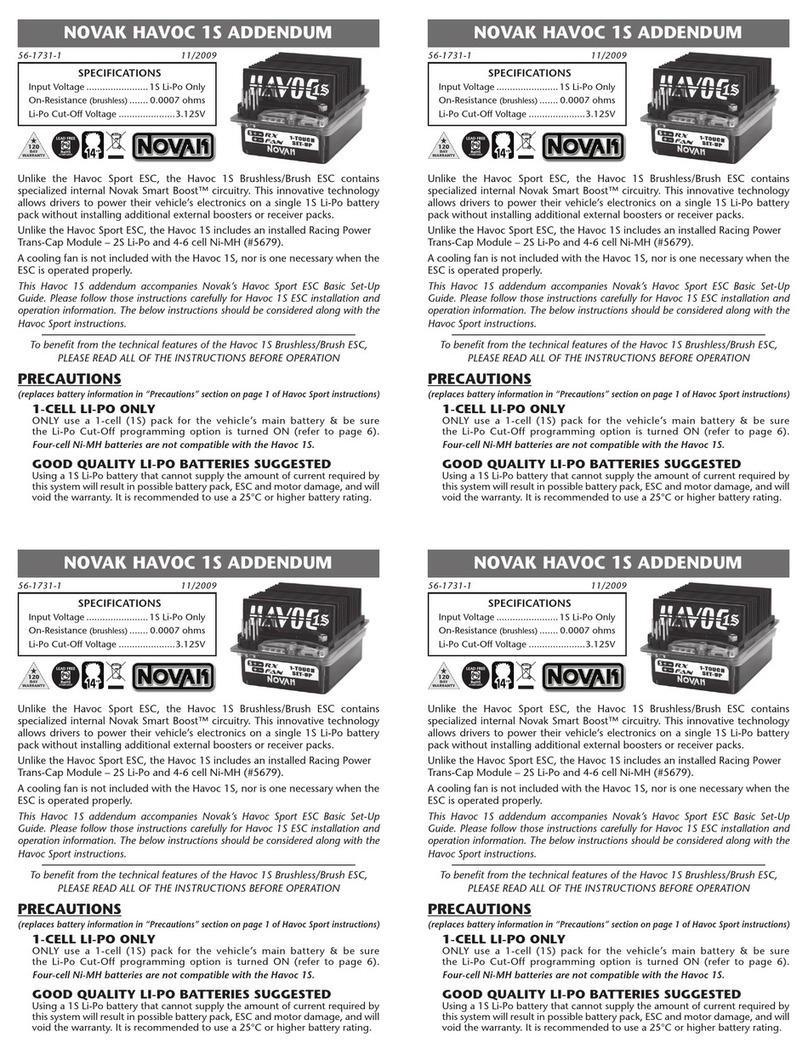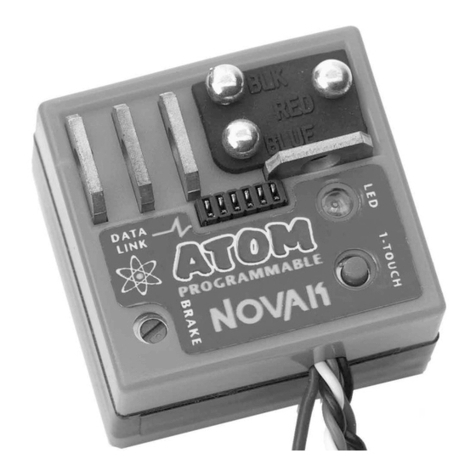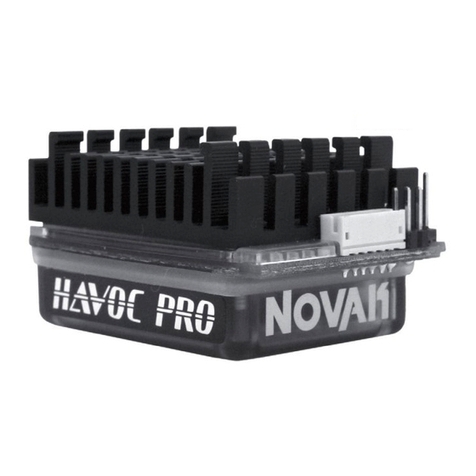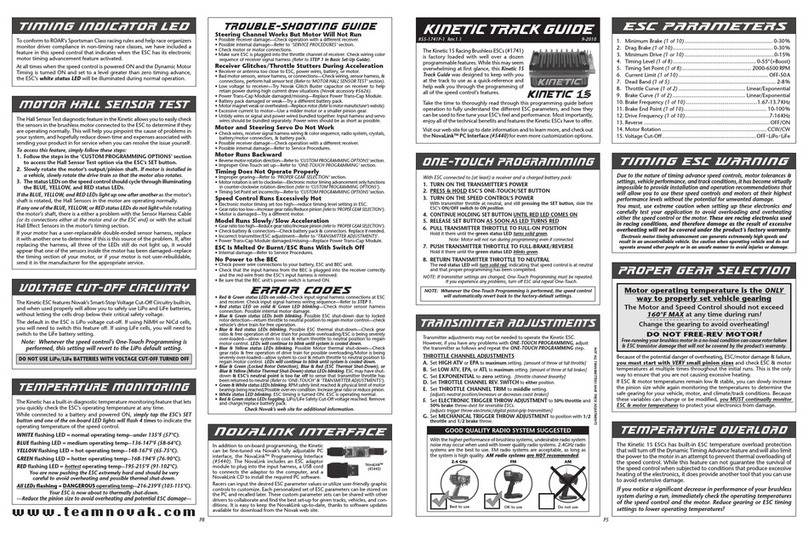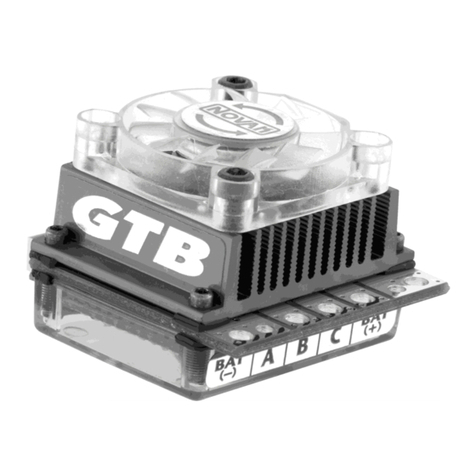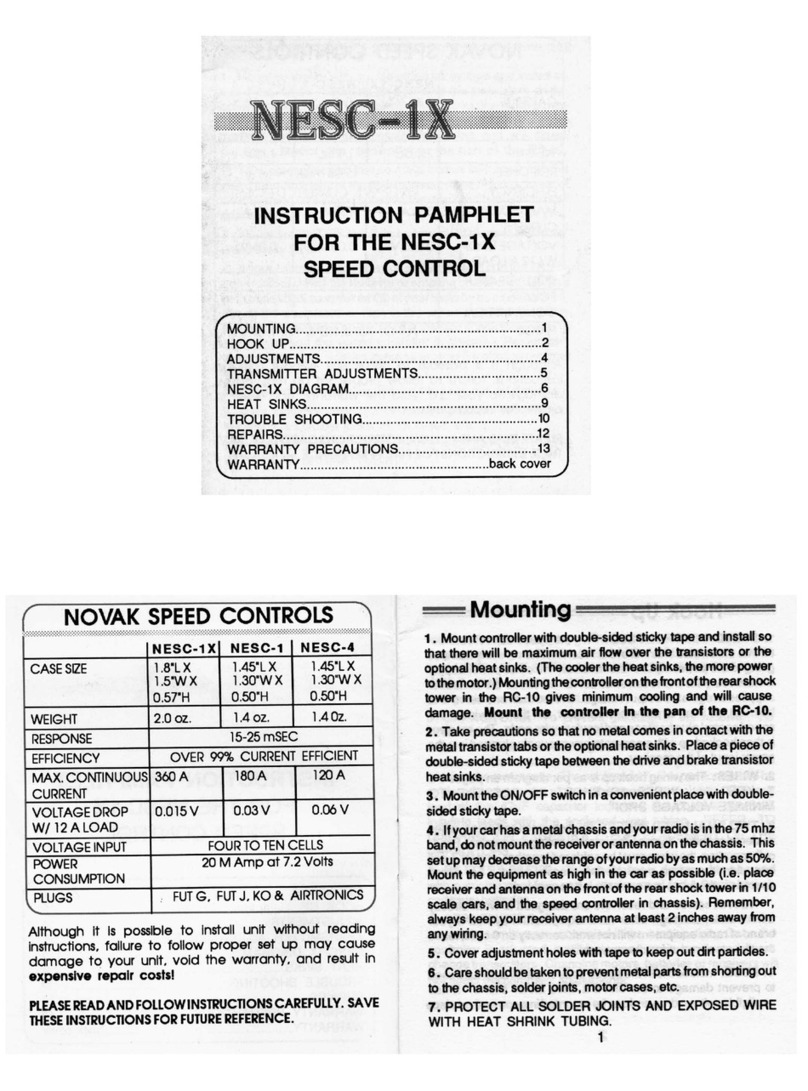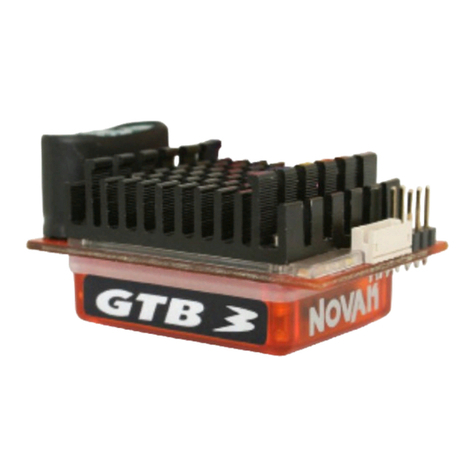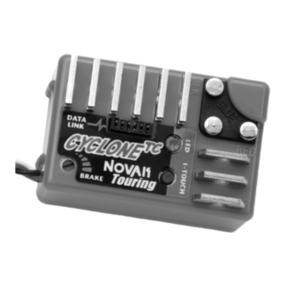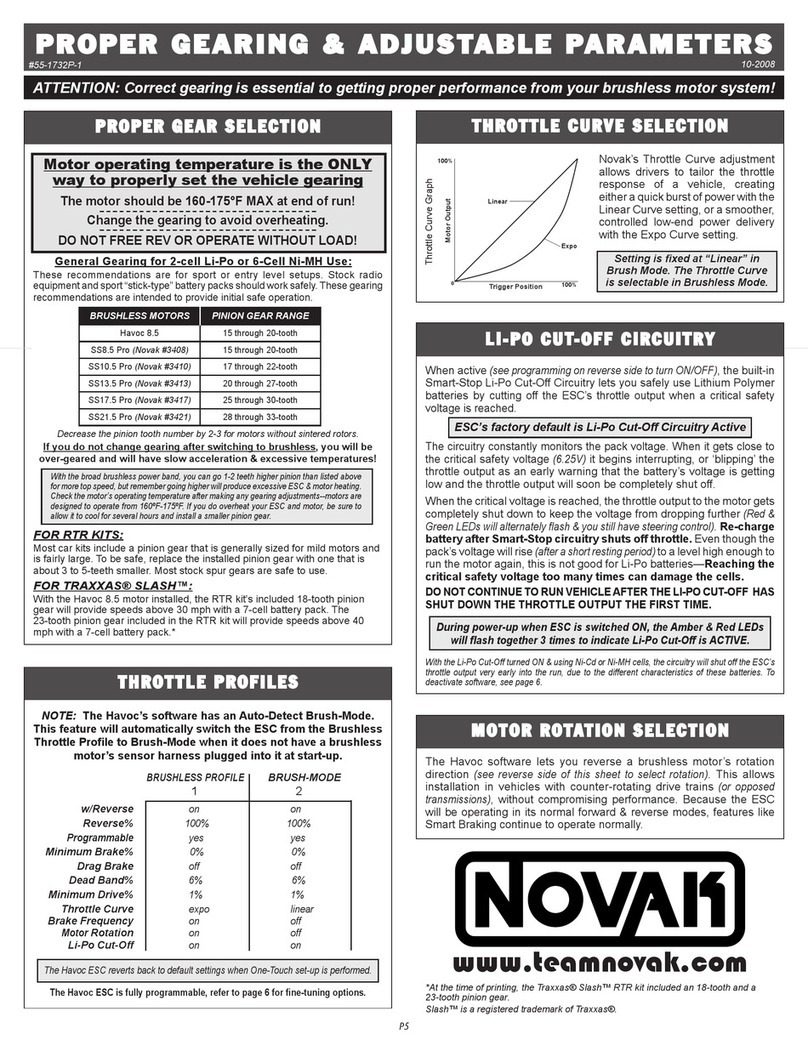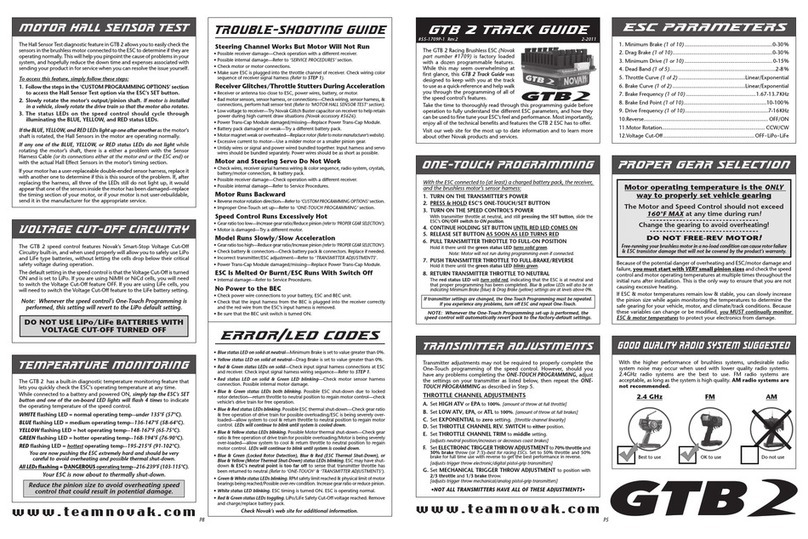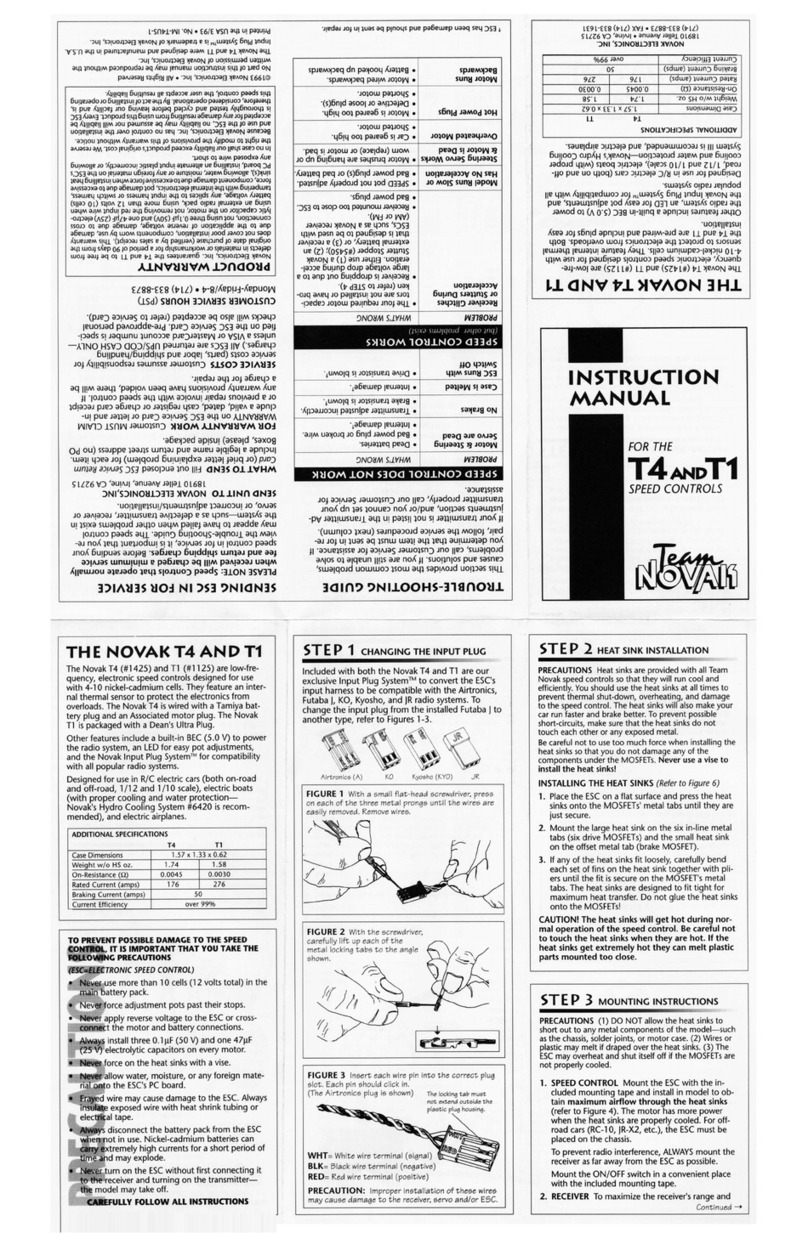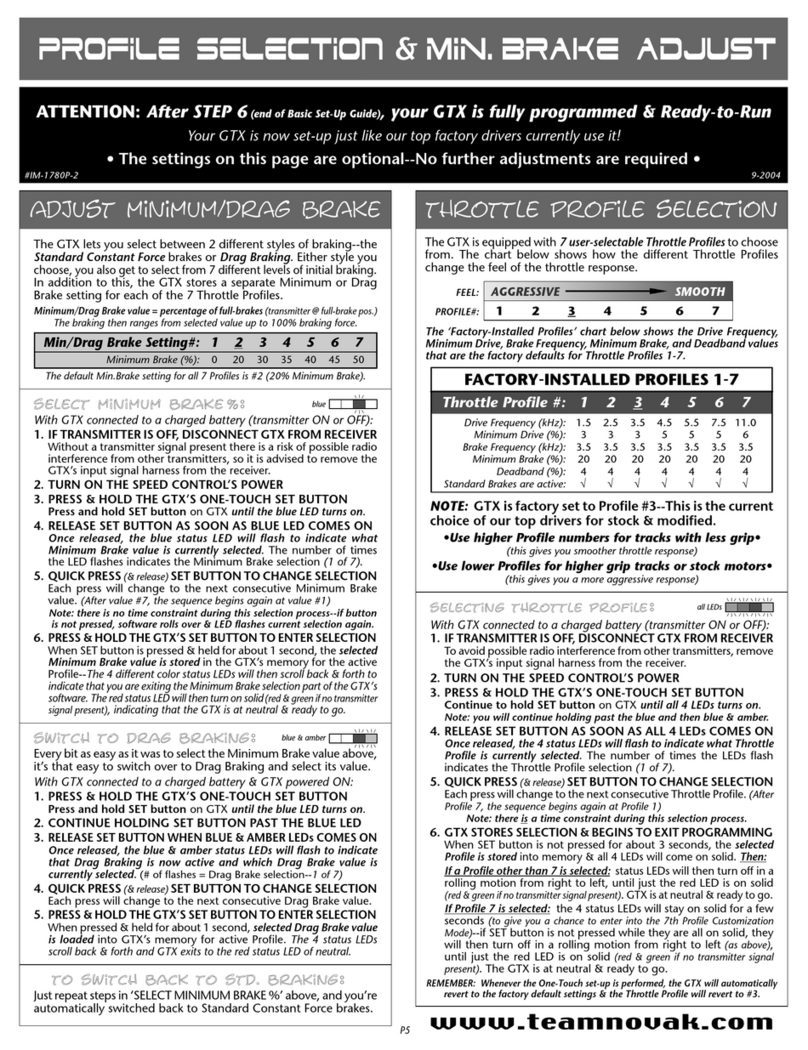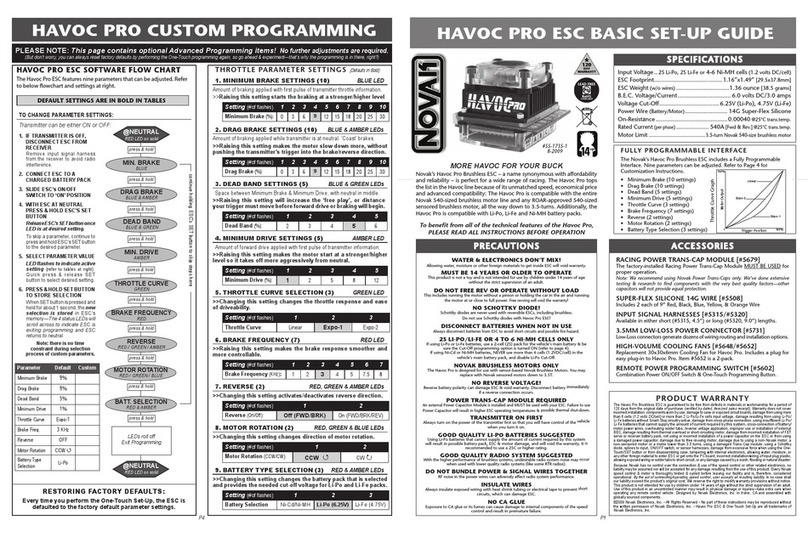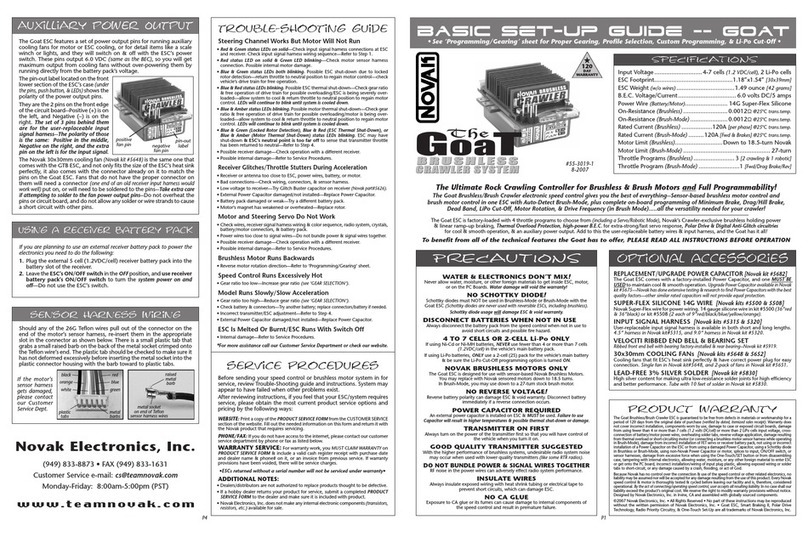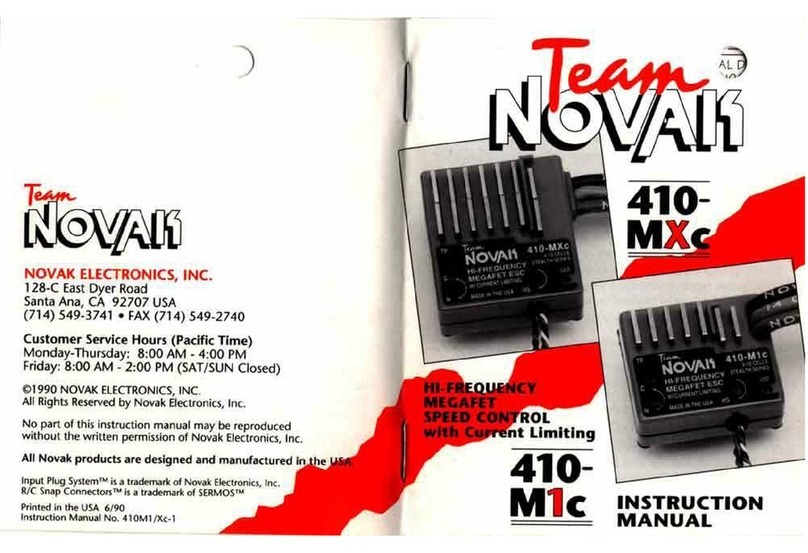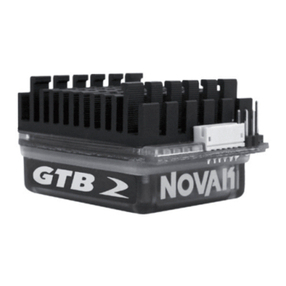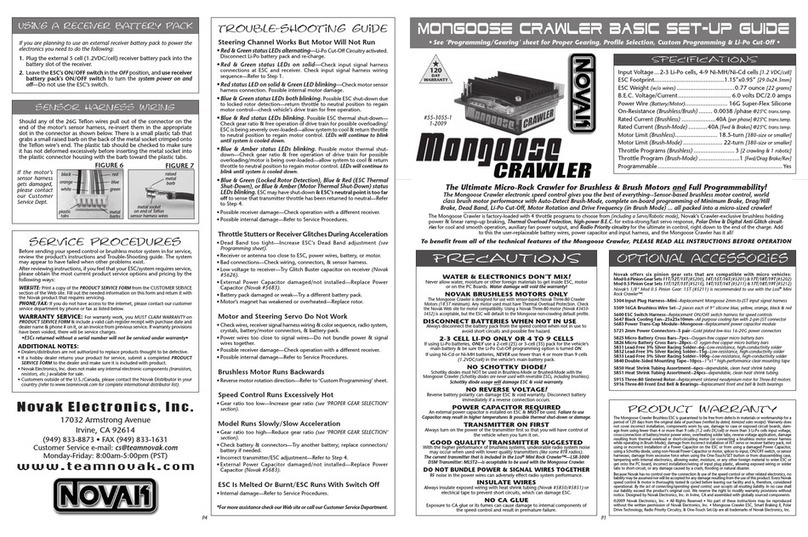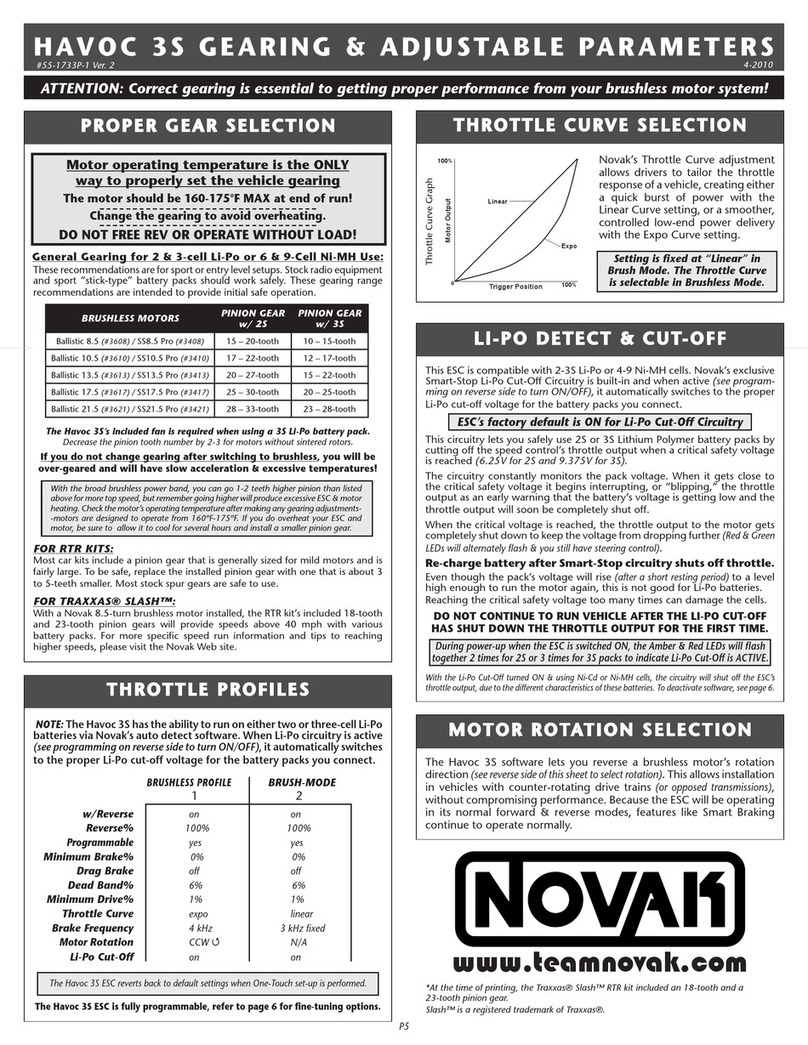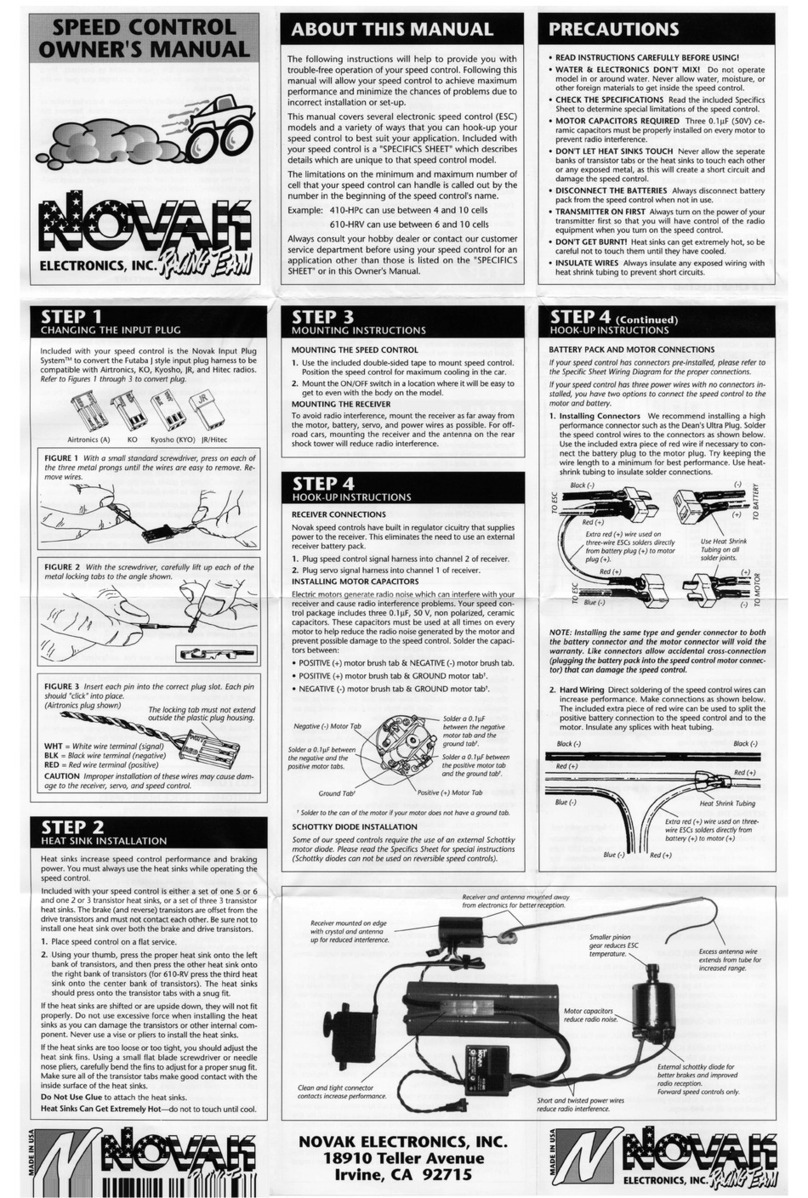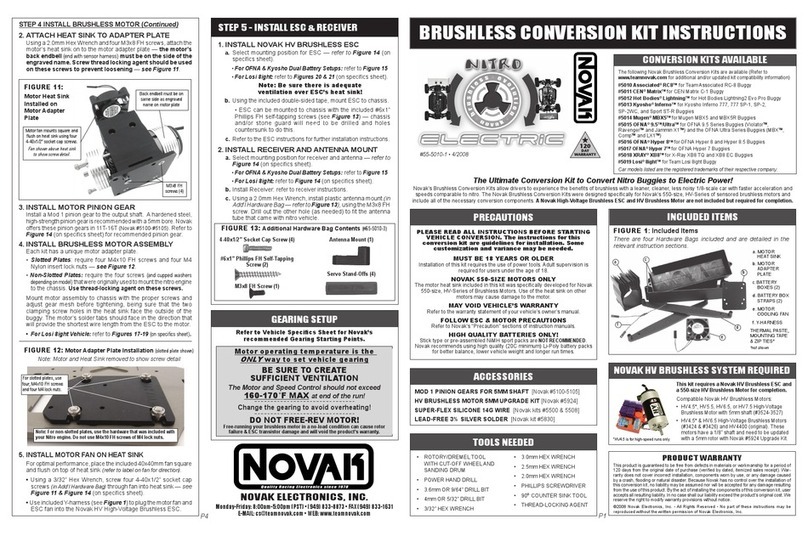#55-1732-5
11-2010
SPECIFICATIONS
Input Voltage ............................................. 2S LiPo, 4-7 cells (1.2 VDC/cell)
ESC Footprint ....................................................
1.18”x1.54” [30x39.1mm]
ESC Weight (w/o wires) ...........................................1.49 ounce [42 grams]
B.E.C. Voltage ......................................................................... 6.0 volts DC
B.E.C. Current .............................................................................3.0 amps
Power Wire (Battery/Motor) ................................... 14G Super-Flex Silicone
On-Resistance ..................................................0.0012Ω
@25°C trans.temp.
Rated Current (Brushless)
.......................120A
[per phase] @25°C trans.temp.
Rated Current (Brush-Mode)
............. 120A
[Fwd & Brakes] @25°C trans.temp.
Motor Limit (Brushless)
....................... Down to 8.5-turn Novak
(@6 cell/2S)
Motor Limit (Brush-Mode)
.............. 27T 540-size motor/12T 550-size motor
Operation
(Sensored Brushless)
.........
Forward/Brake/Reverse (with Rev. Disable)
Operation
(Brush-Mode)
...........................................
Forward/Brake/Reverse
Sensor-Based and Fully Programmable to Wreak Some Havoc!
The Havoc Sport Sensor-Based Brushless System exceeds expectations in performance and affordability. It contains nine adjustable
parameters to fine-tune brake and throttle response, including Throttle Curves and Brake Frequency.
The Havoc Sport ESC is compatible with all sensor-based brushless and brush motors with built-in thermal protection. The Havoc ESC features Novak’s
Smart Braking II, Thermal Overload Protection, high-power B.E.C. for strong/fast servo response, Polar Drive & Digital Anti-Glitch circuitries for cool &
smooth operation, auxiliary fan power output, and Radio Priority circuitry for the ultimate in control, right down to the end of the charge. Add to this the
LiPo Voltage Cut-Off Circuitry, user-replaceable battery wires, power capacitor, & input harness, and the Havoc Sport ESC has it all!
To benefit from all of the technical features of the Havoc Sport ESC, PLEASE READ ALL INSTRUCTIONS BEFORE OPERATION
REPLACEMENT POWER CAPACITOR HARNESS
[Novak kit #5682]
This is the replacement for the Havoc Sport’s factory-installed Power Capacitor, which MUST
BE USED to maintain cool & smooth operation.
SUPER-FLEX SILICONE 14G WIRE
[Novak kits #5500 & 5508]
Novak Super-Flex wire for power wiring. 14 gauge silicone wire in kit #5500 (36”red &
36”black) or kit #5508 (2 each of 9”red/black/blue/yellow/orange).
INPUT SIGNAL HARNESS
[Novak kits #5315 & 5320]
User-replaceable input signal harness is available in both short and long lengths. 4.5” harness
in Novak kit #5315, and 9.0” harness in Novak kit #5320.
30x30x6MM CLEAR COOLING FANS
[Novak kits #5648 & 5652]
Novak cooling fans fit Havoc’s heat sink perfectly & have correct power plug for easy connec-
tion. Single fan in Novak kit #5648 and 2-pack of fans in Novak kit #5652.
LEAD-FREE 3% SILVER RACING SOLDER [Novak kit #5831, 5832 & 5833]
High silver content for making ultra low-resistance solder joints for high efficiency and better
performance. 6g in Novak #5831, 15g in Novak #5832 and 100g in Novak #5833.
LOW-LOSS POWER CONNECTORS–3.5MM
[Novak kit #5731]
High-power, gold-plated connectors for low-resistance and to maximize runtime. 3.5mm
connectors with heat shrink: 5-pair #5731
ESC SWITCH HARNESS
[Novak kit #5600]
Replacement switch for Havoc ESC and all Novak ESCs with switches.
POWER TRANS-CAP MODULE
[Novak kit #5679]
Optional Power Cap Module for improved efficiency and lower operating temperatures.
HAVOC SPORT DESIGNED FOR NOVAK BRUSHLESS MOTORS
This ESC is designed for Novak Thermally Protected Sensor-Based Brushless Motors!
ESC will ONLY operate if motor is replaced with a sensor-based motor (down to 8.5T)
that has built-in thermal protection. Check Novak Web site for motor compatibility.
WATER & ELECTRONICS DON’T MIX!
Never allow water, moisture, or other foreign materials to get inside ESC, motor, or on
the PC Boards. Water damage will void the warranty!
NO SCHOTTKY IN BRUSHLESS-MODE!
Schottky diodes are never used with reversible ESCs, including brushless.
Do not use Schottky diodes with Havoc ESC!
DO NOT FREE REV OR OPERATE WITHOUT LOAD!
This includes running the motor without a pinion or holding the car in the air and
running the motor at or close to full power. Free revving will void the warranty!
DISCONNECT BATTERIES WHEN NOT IN USE
Always disconnect batteries from ESC to avoid short circuits and possible fire hazard.
2S LiPo OR 4 TO 7 CELL NiMH ONLY
If using LiPo batteries, ONLY use a 2-cell (2S) pack for vehicle’s main battery & be sure
the LiPo Cut-Off option is turned ON (refer to page 6). For NiCd or NiMH batteries,
NEVER use fewer than 4 or more than 7 cells (1.2VDC/cell) in the main battery pack.
GOOD QUALITY LiPo BATTERIES SUGGESTED
Using LiPo batteries that cannot supply the required current of this system will result in ESC,
or motor, or battery damage, and will void the warranty. We suggest 25C rating minimum.
NO REVERSE VOLTAGE!
Reverse battery polarity can damage ESC & void warranty. Disconnect battery
immediately if a reverse connection occurs.
POWER CAPACITOR REQUIRED
An external power capacitor is installed on ESC & MUST be used. Failure to use Capacitor will result
in higher temperatures & possible thermal shut-down or damage.
TRANSMITTER ON FIRST
Always turn the transmitter on first so you have control of the vehicle when it turns on.
GOOD QUALITY TRANSMITTER SUGGESTED
With the higher performance of brushless systems, undesirable radio system noise may
occur when used with lower quality transmitters (like some RTR radios).
DO NOT BUNDLE POWER & SIGNAL WIRES TOGETHER
RF noise in the power wires can adversely effect radio system performance.
INSULATE WIRES
Always insulate exposed wiring with heat shrink tubing or electrical tape to prevent short
circuits, which can damage ESC.
NO CA GLUE
Exposure to CA glue or its fumes can cause damage to internal components of the speed
control and result in premature failure.
TROUBLE-SHOOTING GUIDE
Motor Does Not Operate and ESC LEDs Are Scrolling
• Motor may not have temperature protection––ESC will not operate if
used with a motor that does not have built-in Thermal Protection.
Check Novak Web site for the complete motor compatibility list.
• Blue sensor harness may be disconnected––Check connection.
Steering Channel Works But Motor Will Not Run
• Possible receiver damage––Check operation with a different receiver.
• Possible internal damage––Refer to Service Procedures.
Receiver Glitches/Throttle Stutters During Acceleration
• Low voltage to receiver––Try Glitch Buster capacitor on receiver (Novak
part #5626).
• Receiver or antenna too close to ESC, power wires, battery, or motor.
• Battery pack damaged or weak––Try a different battery pack.
• Bad connections––Check wiring, connectors, & sensor harness.
• Motor’s magnet has weakened or overheated––Replace rotor (#5908).
• External Power Capacitor damaged/not installed––Replace Power
Capacitor (Novak #5682).
Motor and Steering Servo Do Not Work
• Check wires, receiver signal harness wiring & color sequence, radio system,
crystals, battery/motor connectors, & battery pack.
• Power wires too close to signal wires––Do not bundle power & signal wires.
• Possible receiver damage––Check operation with a different receiver.
• Possible internal damage––Refer to Service Procedures.
Brushless Motor Runs Backwards
• Reverse motor rotation direction––Refer to ‘Programming/Gearing’ sheet.
Speed Control Runs Excessively Hot
• Gear ratio too low (pinion too big)—Increase gear ratio (use smaller
pinion) (see ‘GEAR SELECTION’).
Model Runs Slowly/Slow Acceleration
• Gear ratio too high––Reduce gear ratio (see ‘GEAR SELECTION’).
• Check battery & connectors––Try another battery; replace connectors/
battery if needed.
• Incorrect transmitter/ESC adjustment––Refer to Step 4.
• External Power Capacitor damaged/not installed––Replace Power
Capacitor (Novak #5682).
• Bad battery––Replace Battery Pack.
ESC Is Melted Or Burnt/ESC Runs With Switch Off
• Internal damage––Refer to Service Procedures.
*For more assistance call our Customer Service Department or check our Web site.
SERVICE PROCEDURES
Before sending your speed control or brushless motor system in for service,
review Trouble-Shooting guide and instructions. System may appear to have
failed when other problems exist.
After reviewing instructions, if you feel that your ESC/system requires service,
please obtain the most current product service options and pricing by the
following ways:
WEB SITE: Print a copy of the PRODUCT SERVICE FORM from the CUS-
TOMER SERVICE section of the Web site. Fill out the needed information on this
form and return it with the Novak product that requires servicing.
PHONE/FAX: If you do not have access to the internet, please contact our
customer service department by phone or fax as listed below.
WARRANTY SERVICE: For warranty work, you MUST CLAIM WARRANTY
on the PRODUCT SERVICE FORM & include a valid cash register receipt with
purchase date and dealer name & phone number on it, or an invoice from
previous service. If warranty provisions have been voided, there will be a charge.
• ESCs returned without a serial number will not be serviced under warranty •
ADDITIONAL NOTES:
• Dealers/distributors are not authorized to replace products thought to be defective.
• If a hobby dealer returns your product for service, submit a completed PRODUCT
SERVICE FORM to the dealer and make sure it is included with product.
• Novak Electronics, Inc. does not make any internal electronic components
(transistors, resistors, etc.) available for sale.
• Products that operate normally will have a service charge.
NOVAK ELECTRONICS, INC.
(949) 833-8873 • FAX (949) 833-1631
www.teamnovak.com
BASIC SET-UP GUIDE — HAVOC SPORT ESC
•See Programming/Gearing sheet for Proper Gearing, Profile Selection, Custom Programming, & LiPo Cut-Off •
PRECAUTIONS OPTIONAL ACCESSORIES
P1P4
SENSOR HARNESS WIRING
Should any of the sensor harness wires pull out of the connector on the end of
the motor’s sensor harness, re-insert them in the appropriate slot in the connector
as shown below. There is a small plastic tab that grabs a small raised barb on the
back of the metal socket crimped onto the wire’s end. The plastic tab should be
checked to make sure it has not deformed excessively before inserting the metal
socket into the plastic connector housing with the barb toward to plastic tabs.
If the motor’s
sensor
harness
gets damaged,
please contact
our Customer
Service Dept.
If you have any problems with Step 4, adjust transmitter as follows and then
repeat One-Touch programming in Step 4:
A. Set HIGH ATV or EPA to 100%.
[amount of throw at full throttle]
B. Set LOW ATV, EPA, or ATL to 100%.
[amount of throw at full brakes]
C. Set EXPONENTIAL to zero setting. [throttle channel linearity]
D.
Set THROTTLE CHANNEL REV. SWITCH to either position.
E. Set THROTTLE CHANNEL TRIM to middle setting.
[adjusts neutral position/increases or decreases coast brakes]
F.
Set ELECTRONIC TRIGGER THROW ADJUSTMENT
to 50%
throttle & 50%
brake throw--best for reversible ESCs.
[adjusts trigger throw electronic/digital pistol-grip transmitters]
G.
Set MECHANICAL TRIGGER THROW ADJUSTMENT to position
with 1/2
throttle & 1/2 brake throw.
• NOT ALL TRANSMITTERS HAVE THESE ADJUSTMENTS •
TRANSMITTER ADJUSTMENTS
USING A RECEIVER BATTERY PACK
The Havoc ESC has an internal 6V/1.5A BEC, so a receiver battery pack is
unnecessary. If you would like to use a receiver battery pack or external BEC,
please follow these steps to ensure normal operation:
1. Connect receiver battery pack/external BEC into battery slot of the receiver.
Receiver battery pack/BEC should have an ON/OFF switch installed.
2. Leave the ESC’s input harness intact. First turn the receiver battery pack ON,
then cycle the ESC’s switch from ON to OFF. The ESC power will remain on
even though the switch is OFF.
After running your vehicle, simply turn OFF receiver battery pack/external BEC.
Always disconnect main battery pack when vehicle is not in use.
PRODUCT WARRANTY
The Havoc Sport Brushless/Brush ESC is guaranteed to be free from defects in materials or workmanship for a period
of 120 days from the original date of purchase (verified by dated, itemized sales receipt). Warranty does not cover
incorrect installation, components worn by use, damage to case or exposed circuit boards, damage from using
fewer than 4 or more than 7 cells (1.2 volts DC/cell) or more than 2 Li-Po cells input voltage,
using insufficient
Li-Po batteries that cannot supply the amount of current required by this system,
cross-connection of battery/
motor power wires, overheating solder tabs, reverse voltage application, damage resulting from thermal overload
or short-circuiting motor (or connecting a brushless motor sensor harness while operating in Brush-Mode), damage
from incorrect installation of FET servo or receiver battery pack,
damage due to free revving of motor, damage
due to using a non-Novak motor, a non-sensored motor or a motor lower than 8.5 turns,
not using or incorrect
installation of a Power Capacitor on the ESC or from using a damaged Power Capacitor, using a Schottky diode in
Brushless-Mode, using non-Novak Power Capacitor or motor, splices to input, ON/OFF switch, or sensor harnesses,
damage from excessive force when using the One-Touch/SET button or from disassembling case, tampering with
internal electronics, allowing water, moisture, or any other foreign material to enter ESC or get onto the PC board,
incorrect installation/wiring of input plug plastic, allowing exposed wiring or solder tabs to short-circuit, or any
damage caused by a crash, flooding or natural disaster.
Because Novak has no control over the connection & use of the speed control or other related electronics, no liability
may be assumed nor will be accepted for any damage resulting from the use of this product. Every Novak speed
control & motor is thoroughly tested & cycled before leaving our facility and is, therefore, considered operational. By
the act of connecting/operating speed control, user accepts all resulting liability. In no case shall our liability exceed
the product’s original cost. We reserve the right to modify warranty provisions without notice. Designed by Novak
Electronics, Inc. in Irvine, CA and assembled with globally sourced components.
©2010 Novak Electronics, Inc. • All Rights Reserved • No part of these instructions may be reproduced without the
written permission of Novak Electronics, Inc. • Havoc Sport ESC, Smart Braking II, Polar Drive Technology, Radio
Priority Circuitry, & One-Touch Set-Up are all trademarks of Novak Electronics, Inc.
ERROR CODES
The Havoc ESC is equipped with internal protection. The following is a list of
error codes depicted through LEDs––most flash when throttle is applied.
• All status LEDs scroll from left to right––Blue sensor harness wire disconnected or motor
does not have temperature protection––Replace blue sensor harness wire or use motor
with temperature protection. Check Novak Web site for motor compatibility list.
• Red & Green status LEDs on solid––Check input signal harness connections at ESC
and receiver. Check input signal harness wiring sequence––Refer to Step 1.
• Red status LED on solid & Green LED blinking––Check motor sensor harness
connection. Possible internal motor damage.
• Blue & Green status LEDs both blinking—Possible ESC shut-down due to locked
rotor detection––Return throttle to neutral position to regain motor control––Check
vehicle’s drive train for free operation.
• Green & Red status LEDs on toggle––Li-Po Cut-Off triggered—Replace or charge
battery. Battery voltage may be too low.
• Blue & Red status LEDs blinking—Possible ESC thermal shut-down—Check gear
ratio & free operation of drive train for possible overloading/ESC is being severely
over-loaded––allow system to cool & return throttle to neutral position to regain
motor control. LEDs will continue to blink until system is cooled down.
• Blue & Amber status LEDs blinking—Possible motor thermal shut-down––Check
gear ratio & free operation of drive train for possible overloading/motor is being
over-loaded––allow system to cool & return throttle to neutral position to regain
motor control. LEDs will continue to blink until system is cooled down.
• Blue & Green (Locked Rotor Detection), Blue & Red (ESC Thermal Shut-Down), or
Blue & Amber (Motor Thermal Shut-Down) status LEDs blinking—ESC may have
shut-down & ESC’s neutral point is too far off to sense that transmitter throttle has
been returned to neutral—Refer to Step 4.
FIGURE 8
metal socket
on end of sensor
harness wires
raised
metal
barb
metal
barbs
red
blue
green
black
orange
white
plastic
tabs
2S SPORT ESC
